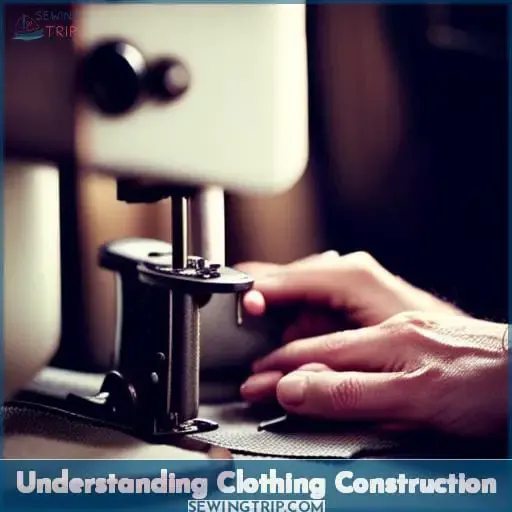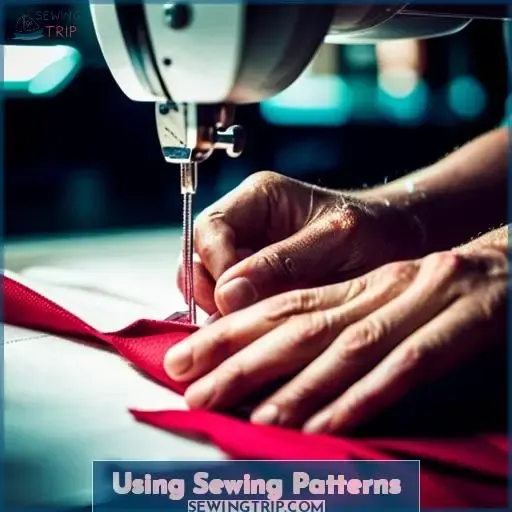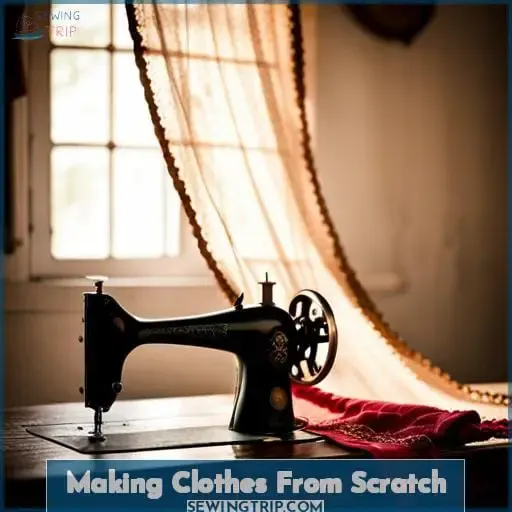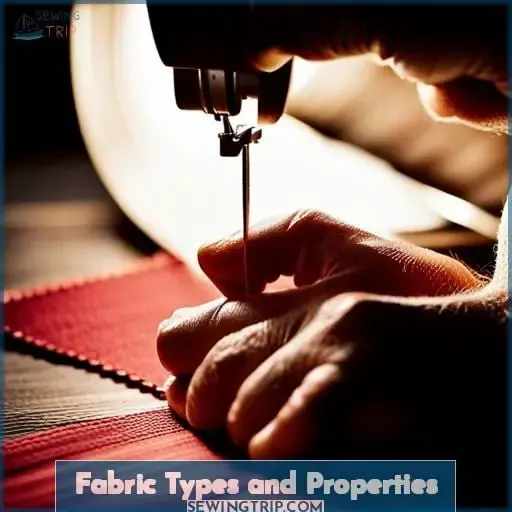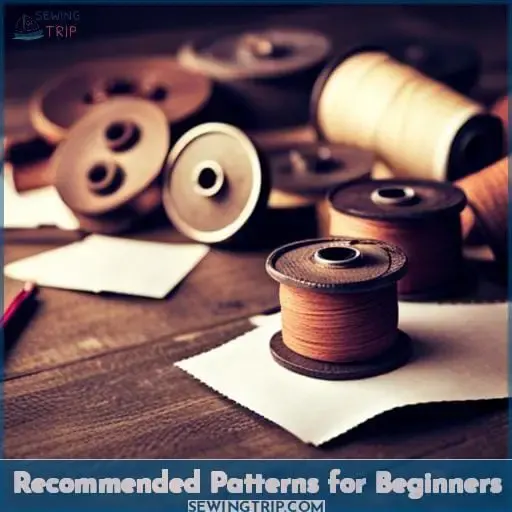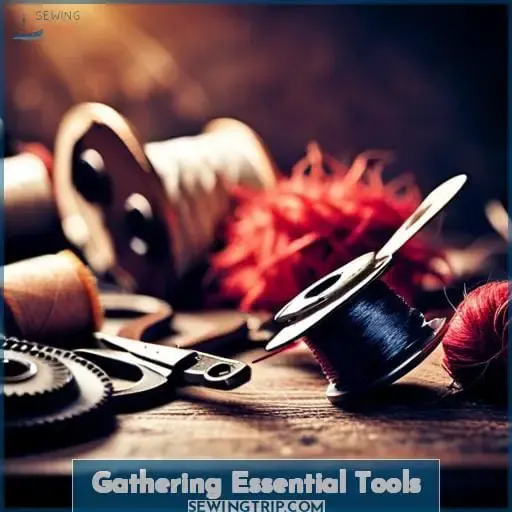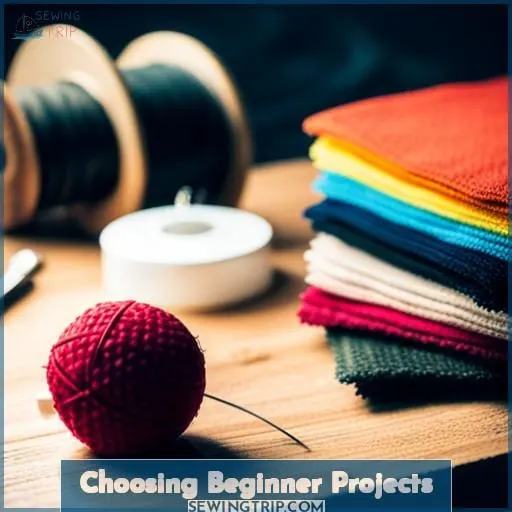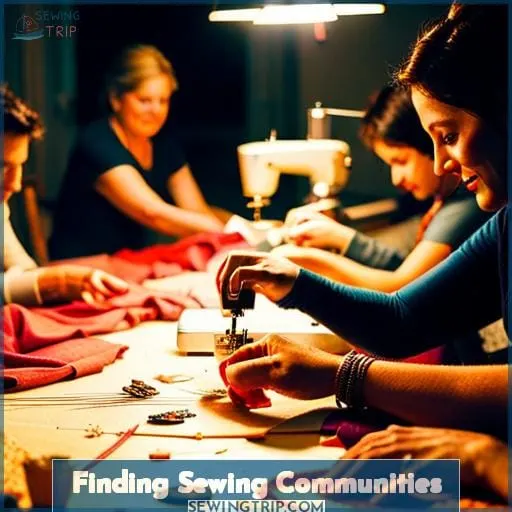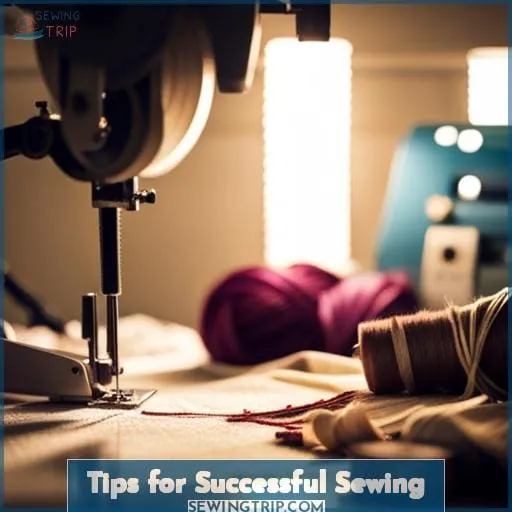This site is supported by our readers. We may earn a commission, at no cost to you, if you purchase through links.
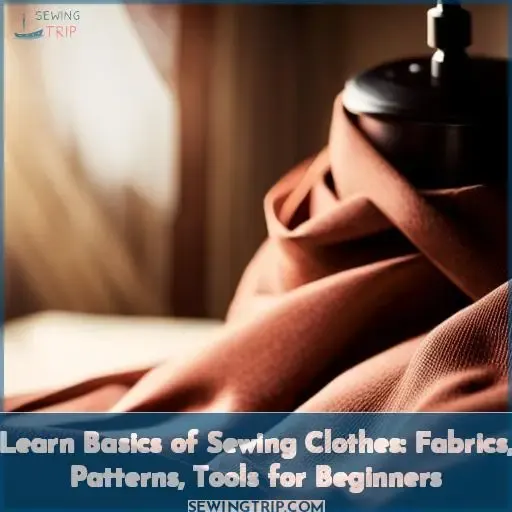
Yet with proper guidance, sewing’s magical alchemy transforms scraps of cloth into couture.
This comprehensive beginner’s guide illuminates sewing’s fundamentals:
- Analyzing garment construction
- Selecting fabrics and tools
Embark on your sewing journey as we:
- Decode patterns
- Experiment with fabrics
- Actualize elegant, imaginative designs
With practice, you’ll gain confidence to:
- Fashion chic garments
- Find belonging in sewing’s creative community
Table Of Contents
- Key Takeaways
- Understanding Clothing Construction
- Using Sewing Patterns
- Making Clothes From Scratch
- Fabric Types and Properties
- Recommended Patterns for Beginners
- Gathering Essential Tools
- Selecting Fabrics
- Choosing Beginner Projects
- Finding Sewing Communities
- Tips for Successful Sewing
- Frequently Asked Questions (FAQs)
- Conclusion
Key Takeaways
- Examine ready-made garments to learn clothing construction techniques like seam allowances and seam finishes
- Choose sewing patterns close to measurements; adjust if needed and follow fabric recommendations
- Sketch designs and drape fabrics to visualize; make custom patterns from measurements
- Select fabrics considering fiber content, stretch, and project difficulty; gather essential tools like scissors, needles, and iron
Understanding Clothing Construction
Let’s examine clothing seams to understand construction.
Deconstruct old clothes to learn pattern making and techniques.
Carefully taking apart garments reveals how they’re put together.
Examining Seams
One effective way to start learning about clothing construction is examining the seams of ready-made garments. This allows you to see how pieces are stitched together in different ways to give shape and structure to the final product.
Pay attention to the seam finishes, allowances, and types of stitches used.
Try this on clothes you already own to get hands-on experience recognizing construction techniques before attempting your own sewing projects.
- Observe seam allowances
- Identify stitch types
- Note seam finishes
Deconstructing Old Clothes
Deconstructing worn-out garments enables you to see how clothes are put together.
Unpick seams and facings to analyze pattern pieces, observe how darts shape garments, and learn finishing techniques.
Reuse intact parts for upcycling projects.
Examine fabric grain, stabilizers, and interfacings.
Educational deconstruction provides sewing pattern and construction insights to inform your own dressmaking and fabric choices.
Using Sewing Patterns
From examining seams, you’re ready to start using sewing patterns for success.
Patterns provide templates and instructions for creating garments. Choose a size close to your measurements, then make adjustments.
When selecting fabric, consider the pattern’s suggestions for fiber content and stretch. Follow any specialty sewing techniques like serging edges or hand-sewing closures.
Watch online tutorials to learn new skills like installing zippers or sewing with knits. Join a sew-along community for guidance on each step from tracing to construction.
Experiment with different techniques as you gain experience. Refer to your pattern’s tips throughout the process.
Making Clothes From Scratch
You can design your own clothes from scratch without using a pre-made pattern.
Sketching design ideas and draping fabric on a dress form allows you to experiment with silhouettes.
With practice, you’ll gain the skills for pattern drafting and making clothes that are uniquely you.
Design Process
To make clothing from scratch:
- Sketch design ideas and drape fabric on a dress form to visualize the drape.
- Draft a custom pattern based on measurements.
Get design inspiration from:
- Sustainable upcycling of old clothes.
Experiment with:
- Different fabrics.
- Personalized adjustments for the best fit.
Use tutorials to help learn proper clothing construction techniques like using a coverstitch machine.
Pattern Making
You’ve sketched design ideas and played with fabric drape.
Now, make your own patterns from scratch to create original garments.
Make alterations to existing patterns for:
- A more personalized fit.
- Creative variations.
- Sustainable repurposing.
Or, take advanced pattern making classes.
Test patterns to perfect the fit before cutting your fabric.
Experiment with both tips from classes and testing good starter patterns to gain confidence in how to sew clothing and utilize different fabric types.
Fabric Types and Properties
Here we’ll explore fabric types and how they impact your sewing projects.
Understanding if a fabric is woven or knit affects everything from pattern and stitch selection to the finished garment’s appearance and durability.
Fabric recovery also influences the fit and lifespan of your makes, so consider it carefully when choosing materials.
Woven Vs. Knit
Once you’ve explored making clothes from scratch, understanding fabric types and their properties is key. Woven and knit fabrics behave differently when sewing garments, so you’ll need to handle them accordingly.
| Fabric Type | Characteristics | Sewing Tips |
|---|---|---|
| Woven | Less stretchy | Use woven needles |
| Knit | More stretchy | Use stretch stitch |
| Woven | Frays easily | Finish seam edges |
| Knit | Recovers shape | Use ballpoint needles |
When selecting fabrics, consider stretchiness, recovery, fraying, and other properties that impact construction and fit.
Fabric Recovery
Their ability to bounce back impacts garment fit and durability, so understand fabric recovery when selecting materials.
Consider a fabric’s stretch and resilience.
Tighter stitches may be required for fabrics with less recovery to maintain the garment’s original shape.
Testing different stitch types on fabric swatches allows you to assess which works best.
Recommended Patterns for Beginners
For beginner sewers, look to the independent pattern companies for user-friendly features when selecting your first few projects.
Simplicity, McCall’s, and Butterick offer great options with detailed instructions and online video tutorials, larger font size, and user-friendly layouts.
Explore quick-sew patterns, often labeled as easy, to build confidence with achievable projects.
Don’t be afraid to trace directly from your clothes or experiment with fabric yardage for initial top and skirt endeavors.
Expect some size adjustments, tracing challenges, and seam ripping as you learn.
Check pattern reviews online and don’t hesitate to ask fellow beginner sewers for advice on Reddit or Instagram as you gain competency.
Embrace the creativity and self-expression sewing allows.
Gathering Essential Tools
After selecting beginner-friendly patterns, the next crucial step is gathering your sewing toolbox.
The key tools for sewing success include:
- A quality sewing machine to handle various fabrics
- Sharp dressmaking scissors for precise cutting
- A seam ripper to correct mistakes
- Straight pins to temporarily bond fabric pieces
- An iron to press seams flat
- A measuring tape for accuracy
Properly maintaining these tools ensures longevity through years of garment construction.
Additionally, stock your notion stash with:
- Thread
- Needles
- Extra bobbins
- Seam gauge
- Fabric marker to mark darts or pleats
Mastering basic sewing machine functions, proper cutting techniques, and ironing methods establishes solid foundations for crafting wearable garments.
With well-equipped hands, you can skillfully handle any project.
Selecting Fabrics
When choosing fabrics, consider fiber content and stretch.
Woven fabrics like cottons and linens are non-stretchy yet easy to sew. Knits stretch and require zigzag stitches.
Test different fabric types to learn sewing techniques before selecting your project’s material.
Beginner Fabric Choices
When selecting fabrics, start by exploring different materials that feel comfortable against your skin.
Consider texture and drape as you select fabrics.
Stay away from slippery fabrics initially.
Pick solids or small prints in cotton wovens or knits to start.
Check fabric content when purchasing, as fiber types have unique properties to understand.
Move toward medium weight fabrics before attempting silks or delicates.
Have fun with color and prints once you feel confident sewing simpler fabrics.
Weave Types For Sewing
Often, you’re deciding between woven and knit fabrics when starting a project.
Consider a woven’s structure and weight for suitable uses—a lightweight woven works for blouses while a heavyweight denim makes durable pants.
Match the fabric’s characteristics to the garment design, modifying patterns for optimal construction.
Finishing seams properly boosts structure.
Experiment with different weave types to gauge sewability—some fray readily while tightly woven fabrics hold shapes neatly.
Choose weaves wisely to ensure enjoyable sewing experiences.
Knit Versus Woven Fabrics
You’ll want to understand the key differences between knit and woven fabrics when selecting materials for your sewing projects.
Knits are:
- Stretchy vs. woven’s structured drape.
- Soft, flexible fiber knits.
- Prone to runs/snags so handle carefully.
- Require stretch stitches and elastic notions.
Choose fabric wisely based on the garment design and your sewing skill level.
Choosing Beginner Projects
When first learning to sew, pick simple pattern styles without closures to build skills.
Use stretchy knit fabrics at first since they are more forgiving.
Then, progress to learning about garment construction by examining finished seams inside clothing.
Pick Simple Pattern Styles
As you start sewing, choose simple pattern styles with few pieces to construct your confidence.
Experiment with easy elastic-waist shorts or basic knit tops first. Adapting these styles helps build skills without intricate construction.
Making small customizations, while anticipating common mistakes, allows creative freedom and confidence building through fabric experimentation.
Use Stretchy Fabrics First
Picking stretchy fabrics like knits for your initial projects helps ease you into handling different materials while learning garment construction.
Choose patterns for tank tops, leggings, t-shirts.
Use jersey, interlock knits, sweatshirt fleece.
Practice straight stitch and zigzag stitching.
Make mistakes – altering knits is forgiving.
Learn Garment Construction
Two more ways you’re advised to choose beginner sewing projects:
- Learn garment construction by starting with simple styles to understand how clothes are put together.
- Use your early efforts to identify areas needing improvement so you can continue honing your skills.
By analyzing seams, exploring patterns through deconstruction, and repurposing techniques, you gain valuable construction education essential for development.
| Project Type | Technique Focus | Desired Outcome |
|---|---|---|
| Elastic Waist Shorts | Applying Elastic | Fit Experimentation |
| Simple Skirt | Waistbands | Ease of Movement |
| Knit Top | Neckband Facing | Wearable Muscle Memory |
Finding Sewing Communities
You can join online sewing communities for guidance and inspiration on your sewing journey.
Online forums provide a wealth of shared knowledge and camaraderie.
Use hashtags to connect with sewers who share your body type.
Seeing finished garments on similar figures builds confidence that you can recreate flattering styles.
Celebrate your sewing victories by posting projects tagging supportive groups.
Sewers unite to troubleshoot obstacles, brainstorm adaptations, and encourage each other’s growth.
The creative energy is infectious; you’ll be motivated to experiment with new techniques and fabrics.
Each small win and connection made swells an empowering sense of belonging to this innovative community.
Tips for Successful Sewing
To ensure your sewing success:
- Thoroughly read the pattern instructions before beginning your project.
- When pinning, insert pins perpendicularly within the 5/8” seam allowance to avoid hitting them with the machine.
- Follow online video tutorials demonstrating proper technique for tasks like setting zippers or sewing darts.
- Enroll in a digital Sew-Along group for guidance through each construction step.
- Adjust the pattern’s finished garment measurements if needed to fit your body.
- Investing in technique books will build understanding of how to handle different fabrics when sewing garments.
With diligent preparation using these tips, your sewing projects will lead to quality finished pieces you love to wear.
Frequently Asked Questions (FAQs)
What are some common beginner sewing mistakes and how can I avoid them?
Rushing through instructions can lead to frustration.
Take your time, read carefully, watch tutorials.
Use pins; don’t force fabric.
Check fit regularly.
Be patient, go slowly to build skills.
Mistakes help you improve.
My sewing machine is jamming, what should I check or adjust to fix this?
Check and re-thread the upper thread, making sure it’s following the correct path.
Inspect the bobbin area for lint buildup.
Adjust the tension settings, starting with the upper thread tension.
Check the needle, replacing it if bent or dull.
Ensure you’re using the appropriate needle for your fabric.
Slow down your sewing speed.
I’m having trouble understanding the pattern instructions, are there any good resources to help decipher them?
Many pattern companies offer sewing tutorials on their websites to help decipher instructions.
Also, check if your local fabric store offers classes. Getting in-person guidance can be invaluable when learning.
Don’t hesitate to ask questions on online sewing forums too. Other sewists are usually happy to help clarify confusing steps.
How do I make adjustments if the finished garment doesn’t fit properly?
Pinch excess fabric at seams and sides to see where it’s too big.
Mark adjustments with chalk or pins.
For tight spots, release seams and insert fabric panels.
Carefully unpick stitching and restitch seams with adjustments.
Experiment on scrap fabric first when possible.
Are there any good beginner sewing projects for learning to sew knit fabrics?
Yes, simple projects like t-shirts, leggings, and tank tops make great first knit projects.
Focus on patterns with minimal shaping to learn how stretchy knits behave on the body and through the sewing machine before attempting more complex styles.
Take extra care with stitch selection and stabilizing seams to get the best results.
Conclusion
As you embark on your sewing journey, remember that practice leads to mastery.
Start simply with knits, analyze constructions, and connect with fellow stitchers.
Soon, you’ll confidently fashion chic garments as sewing empowers your creative spirit.
When threading the needle feels daunting, recall timeless techniques, quality tools, and imagination transform mere cloth into couture.

